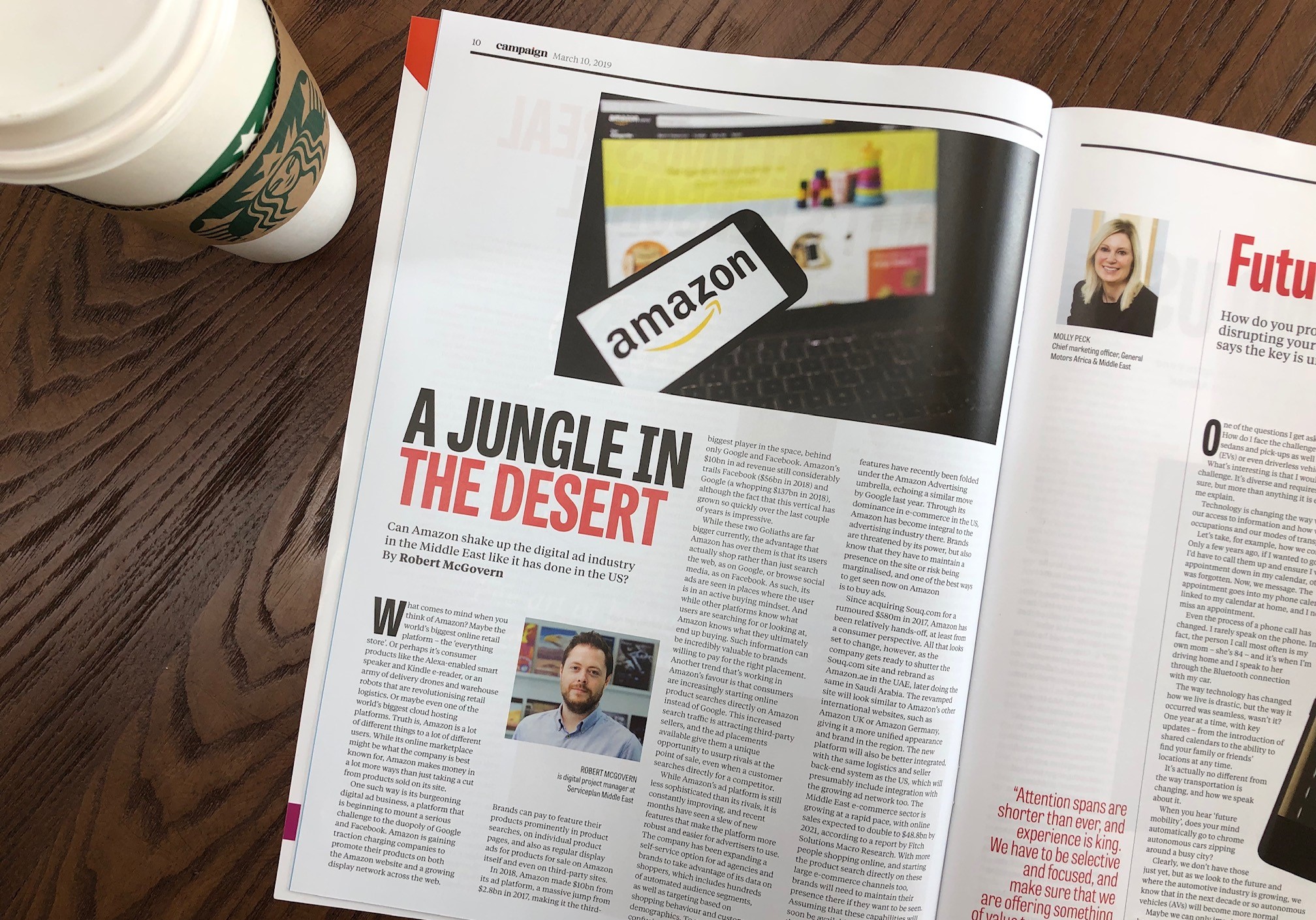Can Amazon shake up the digital ad industry in the Middle East like it has done in the US?
Originally featured in the March 10th 2019 issue of Campaign Middle East magazine
What comes to mind when you think of Amazon? Maybe the world’s biggest online retail platform – the ‘everything store’. Or perhaps it’s consumer products like the Alexa-enabled smart speaker and Kindle e-Reader, or an army of delivery drones and warehouse robots that are revolutionizing retail logistics. Or maybe even as one of the world’s biggest cloud hosting platforms. Truth is, Amazon is a lot of different things to a lot of different users. While its online marketplace might be what the company is best known for, Amazon makes money in a lot more ways than just taking a cut off products sold on its site.
One such way is its burgeoning digital ad business, a platform that is beginning to mount a serious challenge to the current duopoly of Google and Facebook. Amazon is gaining traction charging companies to promote their products on both the Amazon website and a growing display network across the web. Brands can pay to feature their products prominently in product searches, on individual product pages, and also as regular display ads for products for sale on Amazon itself and even on third-party sites.
In 2018, Amazon made $10 billion from its ad platform, a massive jump from $2.8 billion in 2017, making it the third-biggest player in the space, behind only Google and Facebook. To put it in perspective, Amazon’s $10 billion in ad revenue still considerably trails Facebook ($56 billion in 2018) and Google (a whopping $137 billion in 2018), although the fact that this vertical has grown so quickly over the last couple of years is a hugely impressive.
While these two Goliaths are far bigger currently, the advantage that Amazon has over them is that users actually shop on Amazon rather than just search the web as on Google, or browse social media as on Facebook. As such, their ads are seen in places where the user is in an active buying mindset. And while other platforms know what users are searching for or looking at, Amazon knows what they ultimately end up buying. Such information can be incredibly valuable to brands willing to pay for the right placement. Another trend that’s working in Amazon’s favour is that consumers are increasingly starting online product searches directly on Amazon instead of Google. This increased search traffic is attracting third-party sellers and the ad placements available give them a unique opportunity to usurp rivals at the point of sale, even when a customer searches directly for a competitor.
While Amazon’s ad platform is still less sophisticated than its rivals, it is constantly improving and recent months have seen a slew of new features that make the platform more robust and easier for advertisers to use. The company has been expanding a self-service option for ad agencies and brands to take advantage of its data on shoppers, which includes hundreds of automated audience segments, as well as targeting based on shopping behavior and customer demographics. To make it less confusing to brands, all advertising features have recently been folded under the Amazon Advertising umbrella, echoing a similar move by Google last year. Through its dominance in e-commerce in the US, Amazon has become integral to the advertising industry there. Brands are threatened by its power, but also know that they have to maintain a presence on the site or risk being marginalized, and one of the best ways to get seen now on Amazon is to buy ads.
Since acquiring Souq.com for a rumoured $580 million in 2017, Amazon has been relatively hands-off, at least from a consumer perspective. All that looks set to change, however, as the company gets ready to shutter the Souq.com site and rebrand as Amazon.ae in the UAE, later doing the same in Saudi Arabia. The revamped site would look similar to Amazon’s other international websites, like Amazon UK or Amazon Germany, giving it a more unified appearance and brand in the region. The new platform will also be better-integrated with the same logistics and seller back-end system as the US, which will presumably include integration with the growing ad network too. The Middle East e-commerce sector is growing at a rapid pace with online sales expected to double to $48.8 billion by 2021 according to a report by Fitch Solutions Macro Research. With more people shopping online, and starting the product search directly on these large e-commerce channels too, brands will need to maintain their presence there if they want to be seen. Assuming that these capabilities will soon be available in the Middle East, this presents an opportunity for forward-thinking advertisers in the region who are willing to try something new.


